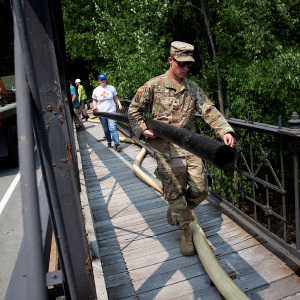Vermont veterinarian serves pet owners with a penchant for the ‘exotic’
| Published: 01-21-2023 11:05 PM |
Dr. Susan Tullar held Gypsy in her arms, murmuring softly to the 15-year-old cockatoo.
“Hello, beautiful girl,” Tullar said as Gypsy’s owners, Eric Jacobson and Blaine Kimsey, looked on.
The couple had driven close to two hours from their home in Wilmington, Vt., earlier this month to see Tullar at the Bradford Veterinary Clinic. It’s a drive they’ve made often since adopting Gypsy a few years ago and nursing her back to health.
The affectionate white bird has health conditions that cause her to pluck out her plumage, and Tullar has been trying to get to the bottom of it.
“She’s our sunshine,” Jacobson said.
Gypsy likes to sit on their shoulders and cuddle. She’s also known to be talkative.
Since adopting Gypsy, the couple has had to travel far distances to find veterinarians to treat her, which is not uncommon for pet owners in rural areas, where veterinarians who have the skill set to treat birds, reptiles and other so-called “exotic animals” can be few and far between.
Tullar, of Lyme, is one of those veterinarians. Since purchasing the Bradford Veterinary Clinic — previously known as Stonecliff — in 2009, Tullar has become known regionally for her care of exotic animals. While the majority of her patients are cats and dogs, a growing percentage are birds, bearded dragons and rabbits, among other species.
Article continues after...
Yesterday's Most Read Articles
“I could definitely tell there was a need,” Tullar, 49, said during a phone interview last month. In addition to veterinary care, Tullar also provides boarding and grooming services.
Tullar traces her interest in exotic pets to her childhood in southern Maine, where she grew up on small farm. She had rabbits and parakeets. After earning a bachelor’s degree from the University of Vermont, she spent a year learning about reptile care at a reptile zoo in Kentucky before attending Cummings School of Veterinary Medicine at Tufts University. During her time at vet school, she pursued internships to further her education in exotic pets and has continued her studies throughout her career.
After graduating in 2007, she took a full-time job at a practice in the Northeast Kingdom and a part-time job at the Bradford practice on weekends help pay down her school loans. She started seeing exotic pets on Saturday mornings.
Tullar bought the practice in 2009, and it now has an average of 10 new patients a month and around half are exotics, Tullar said. They typically make up 10% to 15% of the practice’s patient mix, with the rest being dogs and cats.
When Tullar comes across a case she can’t treat, she refers pet owners to specialists in southern New Hampshire and beyond.
“A lot of it is knowing how to find out because you’re not necessarily educated with every individual species,” Tullar said in December. One of the biggest challenges is figuring out the proper dosage for antibiotics, particularly for smaller pets.
It can be hard for veterinarians with an interest in reptiles to try to further their education or become board-certified in the specialty.
“You’ve got your plate full right now,” Tullar said during an interview at her office earlier this month. “With the economy, the pets and the lack of veterinarians, they have all they can do to keep up with dog and cat medicine, much less try to branch out into more.”
It can also be harder to find those opportunities to branch out, said Dr. Adrienne Snider, a Burlington-based veterinarian who is the president-elect of the Vermont Veterinary Medical Association. If the majority of their patients are dogs and cats, it could be difficult to justify paying for training that would benefit a small number of the animals they see.
“Also, if you’re not able to routinely practice the skills you’re learning (because these pets are a smaller percentage of your patients), it’s harder to retain that muscle memory and comfort level with the skill set,” Snider wrote in an email. “There is the cost of purchasing equipment specific to treating exotics (ex. anesthetic equipment, exam tools, medications) or making changes to the physical practice space to help facilitate care of exotics, and the return on investment may not be there if exotics are not a significant enough part of the practice.”
With the increased need for veterinarian care comes another challenge — recruitment.
This is even more of a challenge in rural areas. Tullar had been looking for a veterinarian to join the practice for around six years before recently hiring someone. Neither of the Twin States has a veterinary school and it’s difficult to convince those who are unfamiliar with rural living to make the move.
“For candidates with spouses and families, they have the additional needs of school/child care access and jobs for spouses,” Snider wrote. “Additionally, there has been an excess of job openings in veterinary medicine, extending back even before COVID-19 times. The current job market makes it especially difficult to compete for employees.”
During continuing education programs, Tullar tries to connect with veterinary students. She offers an internship and the practice — located in the former Upper Valley Press building on Waits River Road — has a studio apartment where interns can live.
Also, a practice cannot function without veterinary assistants, receptionists and others on the 19-person staff. Tullar requires — and pays for — employees to get three credit hours of continuing education each year.
“It is a requirement for employment because every person who works here should be trying to be better at their job,” Tullar said at her practice. “If you don’t want to be better at your job, then I don’t want you here. And we have very little staff turnover.”
Many of Tullar’s employees started working for her when they were young, including Maddie Taylor, of Thetford. Two years ago, Tullar created a pharmacy technician position for Taylor, who is 20.
“She is so patient with me,” Taylor said, adding that she has dyslexia and Tullar is very supportive. If Taylor encounters a problem she can solve, she said, Tullar “walks me through it each time without hesitation.”
Dayna Fisk, of East Thetford, has been working for Tullar for around four years. She came to Bradford with her pets when she was younger and knew from a young age that is where she wanted to work. Fisk started as a receptionist and is now training to be a veterinary assistant.
“She’s approachable and she’s patient and she’s always more than happy to teach you new things,” Fisk said.
Tullar also makes sure her employees are comfortable interacting with all the creatures that come through the doors and the equipment required to treat them.
Among the specialized devices Tullar has is anesthesia equipment for birds like Gypsy.
With assistance from veterinary assistant Josh Hough, Tullar sedated Gypsy to take blood and feather samples to send off to a laboratory for testing for bornavirus and macaw wasting disease.
Other veterinarians the couple have taken Gypsy to recommended she be euthanized, Kimsey said. But not Tullar, who he said is willing to try things that others haven’t.
“She’s always so calm too,” Kimsey said.
Tullar has noticed a shift in the way people approach veterinarian care over the years. More and more, people are willing to get treatment for their pets, and that extends to exotics. Rabbit owners, for example, are more likely to get them spayed or neutered than they used to be.
Medicine has also improved and there are more tools available to treat pets.
“It’s a trap. The quality of care that is coming through veterinary medicine, I think, is improving immensely,” Tullar said. But, she said, that higher-quality care comes at a higher price tag “which people who don’t have the means cannot afford to pay.”
The result is that fewer pets get the care they need “because the quality of that care has gone up, but (people’s incomes) haven’t gone up with it,” she said.
During the early days of the COVID-19 pandemic, Tullar’s practice saw a spike in patients. Pet adoptions were up. People who already owned pets were spending more time at home and picking up on things they might not have in the past. They also temporarily had more money to see to their pets’ needs. But as federal assistance programs ended, that started to change, and beginning last summer, Tullar started to notice that the amount people were willing to spend on their pets’ care was decreasing.
“It’s kind of a shame that the economy is such a huge factor for pet care, but it is,” Tullar said.
Pet insurance can help, but not everyone can afford it and plans aren’t always comprehensive. Insurance options for people with exotic pets are also more limited.
While Tullar promotes preventive care and education with all her patients, it’s a particular focus with exotics. During a first-time visit with Melissa Douse, of St. Johnsbury, Vt., and her rabbit, 7-month-old June Bug, Tullar discussed diet, how to trim nails and what to look for if he’s experiencing medical issues.
“It’s been a learning curve,” said Douse, a first-time rabbit owner who came prepared with a list of questions.
Education is a key part of Tullar’s care, especially with exotics. Sometimes owners don’t fully grasp the level of care reptiles require and what they’re getting into before they decide to own one, which Tullar said is due to a lack of exposure to those types of pets.
“Everyone knows the neighbor’s dog,” Tullar said in December. “Who knows the neighbor’s bearded dragon?”
Liz Sauchelli can be reached at esauchelli@vnews.com or 603-727-3221.

 Some families find freedom with Newport microschool
Some families find freedom with Newport microschool Woodstock Aqueduct Company seeks to double water rates
Woodstock Aqueduct Company seeks to double water rates
